The ultimate guide to contact center modernization
Advanced technologies, omnichannel support, agent performance, data security and ROI are keys to modernizing contact centers, but AI integration and customer personalization dominate.
Today's contact center has come a long way since the days when customers dialed up their rotary phones with a product question for their local customer service department. The modern contact center has evolved from a service desk located in a corner of the local retail store to a call center for inbound and outbound calls to a sophisticated multifunctional operation that serves as the front line of communication between the enterprise and its customers.
The rapid transformation of one-dimensional, phone-based call centers into multifunctional contact centers was propelled by advanced technologies. AI, machine learning, the cloud and CRM ushered in new approaches to engaging customers over multiple channels of communication, including the phone, text messaging, email, web chats, social media and video.
Businesses now have "an unparalleled ability to analyze customer behaviors, honor customer preferences, personalize customer experiences and cultivate teams of customer-centric agents," noted Brian Cantor, principal analyst at Customer Contact Week (CCW), a forum for customer service managers.
While advanced technologies have been the vehicle for contact center modernization, disruptive geopolitical events beyond a company's control over the past few years have been the catalyst that elevated the contact center's importance and accelerated its evolution. Traditional customer relationships suffered during the worst pandemic in 100 years. Lockdowns limited in-store traffic, so the primary lifeline for most consumers and businesses was the contact center. Meantime, contact center agents around the globe had to adapt to working remotely from their homes yet still fulfill their customer service responsibilities.
In this shifting and uncertain business environment, companies refocused their attention on not only gaining new customers but also reconnecting with existing customers in the most convenient and cost-effective way possible. Business strategies dictated upgrading and modernizing the contact centers we see today.
This comprehensive guide examines the transformation and inner workings of the modern contact center, including its benefits, challenges, technologies and trends. Readers will also get a big-picture analysis of what businesses must do to personalize customer interactions and maximize ROI. Hyperlinks, research findings and comments throughout this page connect to related articles that provide additional insights, new developments and advice from industry experts critical to planning, implementing and managing today's complex, multifunctional contact center.
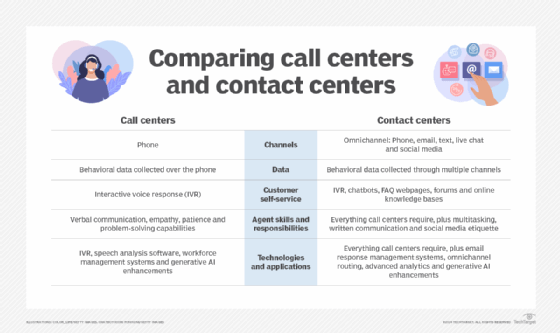
Modern contact centers vs. traditional call centers
Although the terms call center and contact center are sometimes used interchangeably, there are important distinctions between the two entities. Call centers and contact centers both provide customer service and outreach, but they differ in their channels of communication, types of customer data collected, customer self-service (CSS) capabilities, agent skills and job requirements, and technologies and applications.
Traditional call centers existed before the advent of digital communications and use the phone as their primary channel of communication. Contact centers are multifunctional operations that rely on multiple channels, including the phone, email, texting, mobile apps, social media, live web chat and video.
In a call center, inbound calls typically revolve around account inquiries and issues such as technical support, customer complaints and product-related questions. Outbound calls entail telemarketing, fundraising, lead generation, scheduling, customer retention and debt collection.
While many contact centers include a call center, the role of contact center agents is more complex. Multiple channels provide contact centers with a wide range of customer data that can be applied to various analytics to predict behavior patterns and enable customers to interact with businesses on the channel of their choice. The challenge, however, is to provide the kind of personal touch on multiple channels that customers might get in a phone conversation with live agents.
Types of contact centers and their channels
There are essentially 10 types of contact centers. No two contact centers are alike; each one is dedicated to a particular purpose and the communication channels they use, depending on the type of business, contact center's goals, underlying technologies, logistics and staffing. Many of these channels and what they offer customers define the various types of contact centers, such as on premises vs. cloud-based, multichannel vs. omnichannel, and inbound vs. outbound. Consider the following examples:
- On-premises contact centers are built and operated in-house much like a local data center, with all the technology, resources and staffing typically handled by the enterprise.
- Cloud or virtual contact centers provide software-based channels, services and tools via the internet.
- Inbound contact centers typically handle incoming contacts initiated by customers.
- Outbound contact centers generally facilitate customer contacts initiated by the company.
- Blended contact centers support inbound and outbound contacts through the same facility, sharing the traits of both types of contact centers.
- Multichannel contact centers provide a variety of mechanisms or channels for communication.
- Omnichannel contact centers provide and support the broadest possible array of contact mechanisms.
- Outsourced contact centers are fundamentally a contact center as a service (CCaaS), in which some or all of the contact center's functionality is provided through a third party.
- Offshore contact centers are usually located in a country different than the principal business.
- Automated contact centers focus on using AI and machine learning technologies to implement high levels of automation into contact center operations.
When considering voice channels, the telephone comes to mind and is still among the most widely used and most personal forms of communication in the contact center. But with the advent of the internet and cloud, voice channels now include VoIP and virtual phone systems, which can offer some of the same features as the traditional phone.
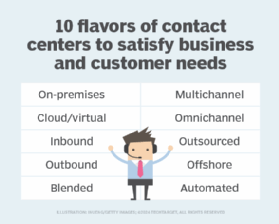
Digital channels have opened the door to various forms of convenient communication, including the following:
- Email enables contact centers to handle high volumes of customer inquiries, saving time that agents and customers would spend during a phone conversation and at less cost. Customers benefit by sending emails at their convenience and saving a documented record of their contact. But depending on the complexity of the inquiry, emails could be more limiting and less personal than a discussion over the phone.
- Live chat, a popular contact center channel, provides customers with an instantaneous means of making inquiries and receiving prompt answers at a company's website. By the same token, businesses can engage customers who are browsing on the company's site. In addition, agents increase their efficiency by handling multiple chat sessions simultaneously.
- Texting or SMS from mobile devices adds to the convenience factor, enabling contact centers to send time-sensitive notifications to customers and resolve customer inquiries quickly without initiating a voice conversation.
- Social media provides a contact center channel for customer inquiries in real time. Contact centers have the option of responding quickly in a public forum to build brand loyalty, gain new customers and establish credibility or opt for a private personalized conversation with the customer.
- Instant messaging in the form of popular platforms such as WhatsApp and Facebook Messenger enables real-time contact center interactions through texting, images and multimedia content to resolve issues quickly.
- Video chat lends itself to personalized in-depth discussions to resolve complex issues, demonstrate products and provide consultations more suited to business clients than general consumers.
- Web forms are a more structured type of contact center communication. Customers can submit their inquiries through online platforms. Contact centers also can conduct customer surveys through website portals.
Self-service channels cater to the notion that sometimes customers are better equipped to resolve their own issues without engaging a live agent. CSS options include the following:
- Interactive voice response automated telephony systems use voice prompts to interact with callers and guide them through different contact options. Customers can respond by voice or keypad until they reach the appropriate destination. Interactive voice response (IVR) systems can also route callers to live agents if necessary.
- Chatbots handle routine customer inquiries and transactions to free up agents for more complex issues. They enable businesses to provide customers with 24/7 service, while reducing contact center overhead costs. Chatbots, however, get mixed reviews from customers who say too often the options offered to solve their specific problem aren't adequate, according to Gartner.
- Virtual agents, especially intelligent virtual agents, are more sophisticated than chatbots. This AI-powered software program and cloud service can answer routine customer queries, fulfill standard requests, handle simple problems and use customer data to personalize interactions. Although they can provide immediate access to relevant information, complex customer questions are typically escalated to human agents.
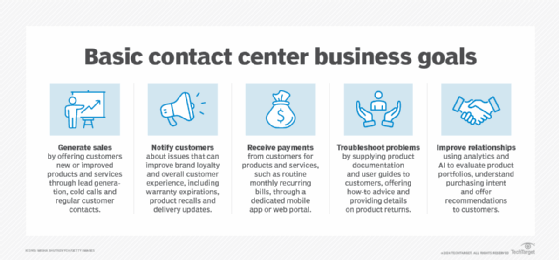
Evolution of the contact center
Telegraph inventor Samuel Morse of Morse code fame sent a telegram proclaiming "What hath God wrought?" from Baltimore to Washington in 1844, and Alexander Graham Bell made the first telephone call in 1876, laying the foundations for what would become the first "call centers" 80-plus years later.
In the 1960s, U.K.-based Birmingham Press and Mail installed private automatic branch exchanges so rows of agents could receive calls from customers; AT&T's electronically switched network replaced manual switchboards; the Bell System developed dual-tone multifrequency technology; and AT&T introduced the first automated toll-free numbers using private branch exchange technologies.
In the 1970s, the automated call distributor (ACD) was developed to help businesses manage inbound calls and IVR systems became commercially available. In the 1980s, AT&T agreed to break up into Regional Bell Operating Companies, opening the door to competition, and outbound call centers used predictive dialing to place multiple calls at the same time to get a live person on the phone.
In the 1990s, the first voice over Internet Protocol (VoIP) service was introduced; the first SMS message was sent; the first smartphone combining mobile phone, pager, fax machine and personal digital assistant was introduced; and General Electric set up its first international call center in India.
Over the next two decades, multidimensional contact centers were propelled by advanced technologies. AI, machine learning, analytics, the cloud, platforms as a service, workflow and workforce management software, collaborative tools, unified communications, CRM, location-based technologies and e-commerce made it possible for companies to engage customers over multiple channels of communication. "They can elevate and scale their [customers'] experiences while also saving money and eliminating friction," CCW's Cantor said.
Business benefits of a modern contact center
Customer centricity, as its name implies, focuses on understanding customer needs and creating a positive contact center experience. Enterprises are discovering that modern contact centers can best fulfill this objective with the aid of sound business goals, advanced technologies and effective agent training techniques.
Customers want their contact center interactions to be fast, seamless, tailored and personal in the form of mobile apps, self-service, improved IVR and knowledgeable human agents. When contact centers can satisfy these customer demands, a multitude of business benefits can be realized, including the following:
- Increased sales and improved ROI driven by dedicated and efficient customer service and support and the ability to provide follow-on product offerings.
- A distinct competitive advantage due to a combination of better service, more sales avenues and customer loyalty.
- A consistent brand and messaging across all available channels.
- More consistent customer service because human agents can access and share customer data and common analytics.
- Improved agent morale and performance because of more tailored and personalized interactions, shorter call wait times and faster resolutions of customer inquiries.
- Significant contact center costs offset by tangible successes, such as sales, and intangible ones like customer loyalty and brand recognition.
- Better product development and more business opportunities by using customer data, CRM and analytics to yield comprehensive customer intelligence.
- A common environment to monitor customer data, improve compliance with privacy laws and protect businesses against groundless legal claims.
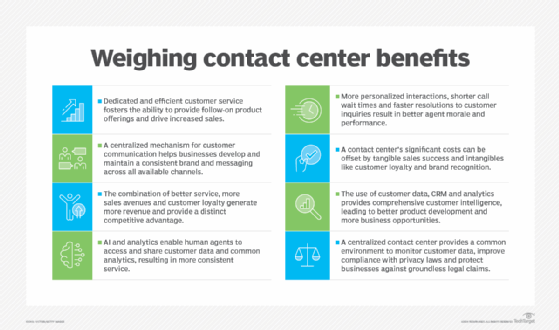
Challenges of modern contact centers
The goal of contact center modernization is to provide consistent, high-quality and personal customer interactions over different channels of communication while managing costs and maintaining operational efficiency. But a lot of contact center functions are siloed or controlled by other departments with different priorities, according to Eric Buesing, partner at McKinsey & Company.
In addition, contact center leaders have yet to attain C-level status. "Although contact center and customer experience teams are increasingly getting an invitation to the executive boardroom, they are rarely sitting at the head of the table," Cantor reported in a 2024 CCW market study on the AI-powered contact center. "Customer contact leaders still answer to overall business executives, who have their own expectations about financial performance." As a result, contact center leaders face increased pressure to justify their modernization efforts and demonstrate their investments are generating ROI.
Justifying investments in different and convenient modes of customer interaction is among the many issues facing modern contact centers. Many contact centers operate with one full-time channel and not with multiple channels, according to Brad Cleveland, senior advisor and co-founder of contact center management consultancy ICMI.
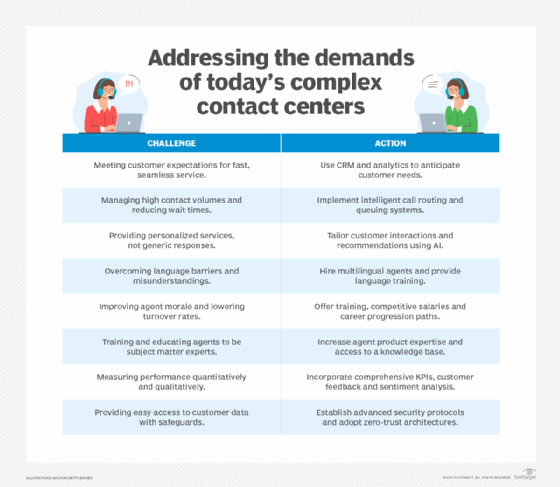
Major contact center issues also include increased customer expectations, agent attrition, mounting customer queues, generalized vs. personalized content, barriers to understanding customer wants and needs, and data privacy, protection and security. Businesses must address the following challenges to maximize their contact center's potential:
- Meeting demands of increasingly tech-savvy customers for fast, consistent and seamless service.
- Managing high call volumes, reducing wait times and elevating agent handoffs.
- Providing tailored personalized services, not generic responses, when the agent isn't human.
- Integrating advanced technologies such as AI and generative AI into existing systems.
- Mounting pressure to implement AI faster and generate returns on those investments.
- Overcoming language barriers and misunderstandings between agents and customers.
- Improving agent morale, reducing agent burnout and lowering rising turnover rates.
- Training and educating agents to be knowledgeable subject matter experts.
- Measuring contact center performance quantitatively and qualitatively.
- Providing agents with consistent, easy access to vital customer data despite privacy safeguards.
With proper funding of and C-level commitment to contact center modernization, these numerous challenges can be remedied by implementing technologies such as AI, analytics, intelligent call routing and CRM; tailoring and personalizing customer interactions; hiring multilingual agents; providing agents progressive career path opportunities; incorporating performance metrics; and establishing data security protocols.

3 pillars of contact center experience
Many moving parts comprise the contact center, but the underlying key components are technology, agents and -- what can make or break a customer's contact center experience -- personalization.
Technology
Advanced tools and technologies are the driving force behind the transformation of the contact center from a cost center into a profit center and its prominent position as the face of the company. They work in combination to meet the needs of businesses, agents and customers in multiple ways, including the following:
- Generating sales by offering customers new or improved products and services.
- Notifying customers about issues that can heighten brand loyalty and overall customer experience.
- Receiving customer payments for products and services through a dedicated mobile app or web portal.
- Troubleshooting customer problems by supplying product documentation and offering how-to advice.
- Improving customer relationships by understanding purchasing intent and offering recommendations.
Agents
Contact center agents, whether human or virtual, are the frontline representatives of the business and thus shape a customer's first, and perhaps last, impression of the company. Human agents handle incoming and outgoing customer communications for the organization, including account inquiries, customer complaints and support issues.
These agents might also follow various communication scripts when speaking to a customer, identify customer needs, build sustainable customer relationships, upsell products and services, and organize all records of conversations. To handle these tasks, agents must possess several skills and qualities, including being detail-oriented, knowledgeable about products, empathic and friendly, calm under pressure and an effective communicator.
Many organizations now use virtual agents to answer routine customer queries, fulfill standard requests and handle simple problems over the phone or at company websites. More complex or unresolvable issues are usually handed off or escalated to a human agent to avoid a bad customer experience.
Personalization
Personalization can be viewed as the intangible element of the three contact center pillars, but without personalization, the ultimate purpose of technology and agents in the contact center -- customer satisfaction and ROI -- would be unfulfilled. Personalization isn't a thought or idea, it's a tool that helps make sense of collected customer data and tailor interactions -- whether written or verbal, on a website or over the phone -- to the specific product, service or support needs of the customer. It plays a critical role in customizing experiences, retaining customers, building customer trust and securing brand loyalty.
The overuse of AI and automation in contact centers can be a turnoff to customers. Personalization tools can provide human, and perhaps virtual, agents with intelligence that enables them to connect emotionally and empathize with customers, understand their needs and resolve complex issues during contact center interactions.
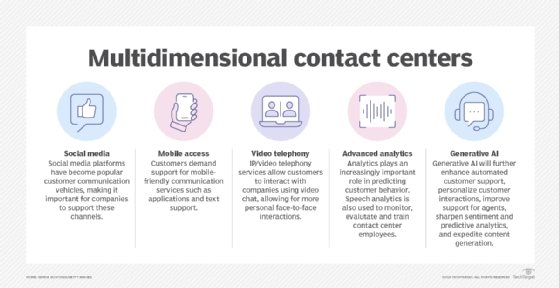
Modern contact center tool features and uses
A modern, fully equipped contact center is supported by several technologies and features that not only focus on personalizing customer experiences using behavior analytics, customer sentiment analysis and voice of the customer, but also on improving operational and management efficiencies, unlocking siloed data, improving agent collaboration, monitoring and improving agent performance, managing agent schedules and even upselling and sales conversions -- all while lowering the overall costs of running the contact center.
Contact center technologies and features include the following, from basic to more complex integrations:
- VoIP-enabled devices, TTY/TDD communications and toll-free telephone services.
- Automatic call distribution to identify and route calls to the appropriate agents.
- Call escalation, call queuing, call routing, call recording, call monitoring, call transcription, call whisper and call back to improve customer-agent interactions and ensure contact resolutions.
- IVR systems to interact with callers, gather information and route calls to the appropriate agents.
- Email response management systems to manage and organize inbound and outbound emails.
- Cloud-based platforms as a service, including CCaaS for contact center infrastructure and applications, UCaaS for communications and collaboration services and CPaaS for adding communications to business applications and processes.
- Chatbots to assist customers with basic questions and tasks without a live agent, enabling customers to self-serve and agents to focus on more complex issues that require human interaction.
- Workforce management systems to optimize agent productivity by forecasting labor requirements and creating staff schedules.
- Data analytics to measure KPIs, evaluate agent performance and identify areas for improvement.
- CRM integration to facilitate data flow and give agents access to customer profiles and previous interactions for more personalized support.
- Customer data platform integration that combines real-time data from all customer touchpoints across channels to create a centralized customer database, tailor customer experiences and provide hyperpersonalized support for customer retention and loyalty.
- Omnichannel integration across phone, text, live chat, social media, video and voice to facilitate data flow and enable agents to engage customers across channels.
- Unified UI to bring all contact center channels and integrations into a single dashboard.
- Multilanguage support to overcome language barriers and misunderstandings between agents and customers.
- Post-contact surveys to enable customers to provide feedback about their contact center experience and help companies track customer satisfaction trends over time.
- Self-service portals to enable customers to resolve issues and inquiries without engaging with virtual or live agents and reduce the volume of live engagements contact center agents must handle.
- Generative AI integration to improve technologies and multiple contact center functions.
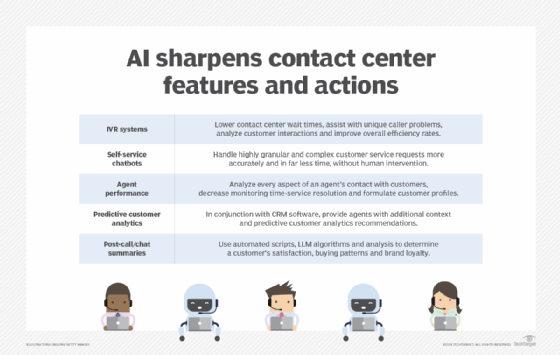
How are AI and automation transforming contact centers?
AI and automation permeate every aspect of contact center operations. Without these technologies, contact centers wouldn't have evolved into the multifunctional juggernauts they are today. Automation facilitates fast and efficient responses to customer contacts and agent workflows, while AI provides valuable customer intelligence and insights. When a call comes into a contact center, for example, ACD will automatically route the call to the right agent based not only on availability but on what the AI tool deems to be the agent best suited to handle the call and interact with the customer.
Automation
Call center automation systems complete repetitive, and possibly time-consuming, tasks without human intervention so agents can turn their attention to more important actions like solving a complex customer issue. Technologies such as voice AI, ACD and robotic process automation typically lower contact center costs and help improve customer experience by providing prompt, seamless service.
Generative AI, while still in its infancy, possesses unlimited potential for the contact center. At present, however, it can create problems that range from hallucinogenic responses to data privacy concerns. McKinsey estimates that applying GenAI and other technologies to customer service functions can potentially automate work that currently takes up 60% to 70% of a worker's time.
AI
There are two main types of AI in the contact center. Conversational AI uses large language model (LLM) algorithms and natural language processing, which lets customers converse with voice- and text-based IVR systems, chatbots and virtual assistants. AI-powered data analysis sifts through various statistics and KPIs and makes suggestions on ways to improve performance or increase customer satisfaction. The following AI-powered systems are among the more popular and beneficial features integrated into contact center platforms:
- IVR. Lowers contact center wait times, assists with unique caller problems, analyzes customer interactions and improves overall efficiency rates.
- Agent performance monitoring. Analyzes every aspect of an agent's contact with customers, decreases monitoring of time to service resolution and formulates customer profiles.
- Predictive customer analytics. Works in conjunction with CRM software to provide agents with additional analytics context and customer analytics recommendations.
- Post-call/chat summaries. Use automated scripts, LLM algorithms and analysis to determine a customer's satisfaction, buying patterns and brand loyalty.
- Self-service chatbots. Handle highly granular and complex customer service requests more accurately and in far less time, without human intervention. Consideration is also being given to deploying intelligent bots in multiple channels, including messaging, email and voice.
But AI isn't necessarily the magic bullet that will replace human agents. "Executives see AI as the golden ticket item for customer service," Christopher Sladdin, director analyst for Gartner's customer service and support practice, told TechTarget Editorial. "There's a common belief that it may finally reduce the headcount in the contact center. That's not really reality."
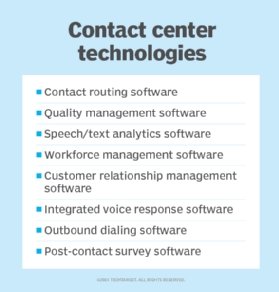
Customers don't look fondly upon the current capabilities of chatbots and other automated systems, according to Gartner. They often find interactions with AI to be inadequate. Businesses under immense pressure to maximize their large investments in AI could be walking a thin line between improving the contact center experience and force-feeding the technology to customers. More than half of 5,728 consumers surveyed by Gartner indicated they would consider switching to a competitor if a customer service organization planned to use AI during interactions. The top concern acknowledged by 60% of consumers surveyed is it will be harder to reach a human, while 42% fear AI will provide them with the wrong answers.
Vendors are working to correct this problem over the next year by increasing the integration of AI into their tools, according to Jack Gold, president and principal analyst at consultancy J. Gold Associates, but most contact centers are slow in adopting them. Enterprises are becoming more strategic with their contact center AI investments and focusing on a few key AI use cases rather than blanketly investing in all things AI, CCW's Cantor reported. ICMI's Cleveland advises contact center managers to be "clear-eyed" about what their workloads will be in the next few months, budget accordingly and don't assume AI will replace everything.
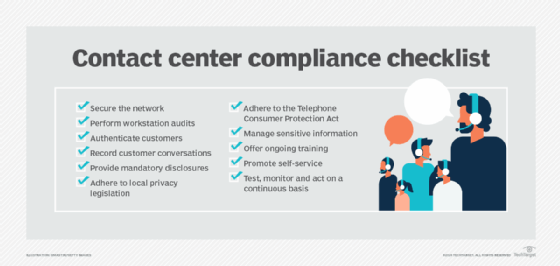
How to train and manage contact center agents
In addition to increasing ROI, a well-conceived and well-executed contact center agent training program can reduce agent burnout and turnover, boost technical and product knowledge, improve agent performance and produce better customer experiences. The following best practices should be included in a successful agent training and education program:
- Align the program's goals and objectives with the company's business strategy.
- Create role-based KSAC -- knowledge, skills, abilities and culture -- profiles for each agent.
- Analyze training needs to match the desired outcome and identify KSAC deficiencies.
- Follow metrics and measurements to develop an ROI model for training.
- Determine training phases beyond the agent's first 30, 60 or 90 days on the job.
- Combine training, quality and coaching since they consistently feed off each other.
- Tailor training programs to an agent's preferred style for a better learning experience.
- Solicit agent feedback and recommendations throughout the training process.
- Recognize and reward success based on quiz scores, completed projects, certifications and customer testimonials.
- Add in elements of fun and enjoyment throughout the training process as part of the organization's culture.
In the era of hybrid and remote workforces, managing contact center agents might not be as traditional as it once was. As contact center agents have opportunities to handle more complex issues, upskilling programs can play a key role in preparing agents for different and expanding responsibilities.
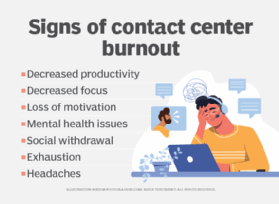
The biggest high-level contact center trend has been to improve agent efficiency, according to Irwin Lazar, president and principal analyst at research firm Metrigy. Contact center managers have reported their agents are feeling frustrated because they couldn't get the information customers needed, resulting in poor customer service. Managers should consider the following strategies to keep agents motivated, productive and current and ensure that the company's education and training program is effective:
- Analyze the data gathered from an agent's quality assurance evaluation and conduct one-on-one sessions with agents working in the office.
- Use call monitoring software to review recorded contacts or listen to them in real time.
- Identify performance shortcomings using various KPIs and metrics such as average handling time and first contact resolution.
- Be transparent with agents about evaluation metrics and make their assessments constructive and educational.
- Develop agent skills with additional training, reference materials and an easily accessible knowledge base.
- Motivate agents by recognizing and praising incremental improvements in their performance.
- Relieve agents of time-consuming tasks by offloading basic customer inquiries to virtual agents.
- Foster 24/7 customer self-service channels to take some pressure off front-line agents.
- Emphasize skills-based routing so routed calls and inquiries best align with an agent's skill level.
- Involve agents in decision-making, ask for their feedback and provide them with the proper tools.

How to deliver personalization in the contact center experience
Despite the range of technologies and features available to improve contact center efficiencies and customer convenience, the reality is that businesses still have a long way to go to achieve customer experience perfection.
Consumers regarded 2023 as "just another year of disappointing interactions with brands that barely know, let alone care about, the customers they are serving or issues they are addressing," Cantor reported. The overwhelming majority of consumers feel their typical experiences are inefficient, inconvenient and impersonal. Cantor warned if businesses don't deploy human-centric AI tools, "they will only compound the frustration their customers and employees are facing." Business leaders are getting the message. Customer loyalty surveys conducted by management consultancy PwC revealed that 61% of executives ranked personalizing the customer experience a high priority -- ahead of any other loyalty strategy.
Personalization starts with gathering and analyzing relevant customer data to establish complete profiles of customer needs and preferences. Customers can then be segmented into groups that share similar characteristics. Contact center agents need to have access to this information so they can better understand the customer's wants and needs, empathize with the customer's situation and bring a personal touch to the conversation. Agents need to be good listeners and communicators, but they also need to be proactive in resolving the customer's issue.
Personalization isn't just limited to phone calls. It can be delivered over other channels, including emails, live chats, IM, websites, social media and video. For simple customer inquiries, virtual agents and chatbots can be programmed to tailor and personalize their response. To gauge the effectiveness of personalization efforts, customers should be encouraged to provide feedback on their experience.
Even though businesses are investing in self-service technologies, a ServiceNow survey on customer service insights in the GenAI era reported "there's nothing like the human touch for resolving customer service requests."
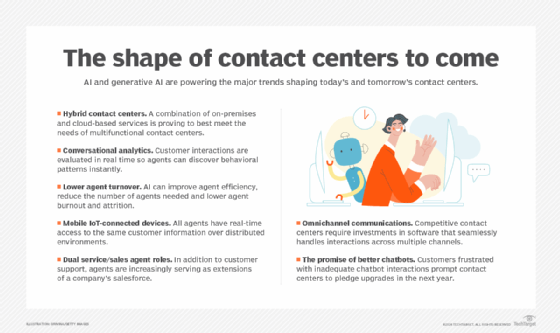
7 modern contact center trends to watch
AI and generative AI are powering the major trends shaping today's and tomorrow's contact centers as businesses seek to resolve issues surrounding siloed functions, AI integration, IT costs, agent productivity, agent turnover rates, omnichannel customer support and hybrid operations. The following seven trends for 2024 and beyond address these issues:
- A combination of on-premises and cloud-based services are proving to best meet the needs for multifunctional contact centers.
- Conversational analytics evaluates customer interactions in real time so agents can discover behavioral patterns instantly.
- AI can improve agent efficiency, reduce the number of agents needed and lower agent burnout and attrition.
- Mobile IoT-connected devices enable all agents to have real-time access to the same customer information over distributed environments.
- In addition to customer support, agents are increasingly serving as extensions of a company's sales force.
- Competitive contact centers require investments in software that seamlessly handles interactions across multiple channels.
- Customers frustrated with inadequate chatbot interactions are prompting contact centers to pledge upgrades in the next year.
Ron Karjian is an industry editor and writer at TechTarget covering business analytics, artificial intelligence, data management, security and enterprise applications.







